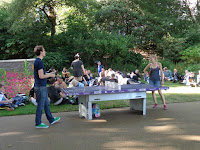If you ask me, the biggest celebrity of the United Kingdom, royal or not, will always be William Shakespeare. I was a little surprised by the limited homage paid to the playwright in London. A statue of him in Leicester Square goes almost unnoticed as people head to M&M's World (top left). And when a friend and I visited Shakespeare's Globe (top right), which is a reconstruction of the original that sat only a little ways away, we were in a small group touring the seats and stage (bottom left). Despite their appearance, the columns on the stage are made entirely from wood (bottom right), which is why the original theater burned to the ground in less than two hours after a stage cannon caught the thatched roof on fire.
Of course, Shakespeare has to share the spotlight with other impressive icons of the arts. A beer tour I took started at Bunhill Fields Burial Grounds, where there is a monument to Daniel Defoe, author of Robinson Crusoe (left), and the grave of William Blake, writer of "The Tyger" and "The Lamb" (right).
And London surrounds you in the works of some titans of architecture. The Temple Bar Monument marks where architect Christopher Wren's Temple Bar once stood as a stony symbol of the entrance to London from Westminster (left). Right down The Strand stands the only building that survived the Great Fire of London. The lawyers' and journalists' Wig and Pen Club closed in 2003, and it is now a Thai Square restaurant (right).
The bulk of the country's history -- artistic, architectural, and especially archaeological -- is housed in the British Museum (top left). The museum's pièce de résistance is the Rosetta Stone, which is swarmed so much by patrons that it can hardly, ironically, be read (top right). The most controversial display, perhaps, is the Elgin Marbles (bottom). In the 1980s, the Greek government started asking for the Parthenon sculptures, which a British ambassador removed to the United Kingdom in the early 19th century, to be returned.
Often, UK museums are as much pieces of art as those they contain. That is certainly true for the Tate Britain, which houses mostly British art (top left), as opposed to the Tate Modern, which has a large collection of international works. The main gallery was built on the site of the penitentiary that housed prisoners on their way to Australia (top right), but it has had many additions, including a wing that now features a sculpture made entirely of toast. Not every museum is buttoned-up, as was clear through the prints at the pop-up Mr. Men Little Miss Mini Museum (bottom left). They didn't even mind when I stroked the book covers of my youth with nostalgia (bottom right).
Even the most functional buildings in the city could be included on the cover of Architectural Digest. Charing Cross is named after one of 12 Eleanor Crosses marking the funeral procession of Edward I's child bride; the monument outside the railway station is a replica of the cross from Whitehall (top). As its name would indicate, Victoria station was erected in honor of the famous queen (middle left). Waterloo station, a testament to 20th-century high-tech design, once was the UK base of the Eurostar (middle right). The high-speed train from Paris now arrives at St. Pancras (bottom left), which connects via a stunning tunnel to King's Cross station (bottom right).
Amidst all this amazing architecture lies loads of green space, such as Victoria Embankment Gardens (top left). The park, which is near Embankment not Victoria station, puts out ping-pong tables for fresh-air fiends in the summer (top right). The hoards, however, head to Hyde Park, where they can skirt the Serpentine (bottom left). If strollers continue west into the adjacent Kensington Gardens, they will eventually come upon Albert Memorial, a monument to Queen Victoria's husband whose design was based on the Eleanor Crosses (bottom right). 























No comments:
Post a Comment